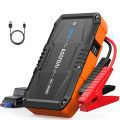In this guide, “How to Troubleshoot Common Car Battery Issues Using a Tester,” we will walk you through a straightforward process for diagnosing a variety of battery-related problems using a battery tester. By understanding the essential steps and techniques outlined here, you will be equipped to identify issues such as weak batteries, poor connections, and other common faults. This knowledge will empower you to ensure your vehicle remains in optimal running condition and help you save time and money on unnecessary repairs.



Gather Necessary Tools
Gather a battery tester, safety gloves, and safety glasses before you begin working on your car battery. A battery tester is essential for checking the charge and overall health of the battery, helping you determine if it needs to be replaced. Choose a digital multimeter or a dedicated battery tester that can provide accurate voltage readings. Safety gloves protect your hands from acid spills and other hazardous materials while handling the battery, and safety glasses shield your eyes from any potential splashes or debris. Ensure that the gloves fit properly and are made of a durable material that resists punctures and chemical exposure.
Wear the safety gear before approaching the battery. Start by putting on the safety gloves and glasses as a precaution against any unexpected incidents. Once suited up, locate the battery in your vehicle, usually found under the hood or in the trunk. Use the battery tester by connecting the positive lead to the positive terminal and the negative lead to the negative terminal. Read the display to check the voltage. If the voltage is below 12.4 volts, consider recharging or replacing the battery. Always handle the battery with care and dispose of any old batteries responsibly at a designated recycling center.


Prepare Your Vehicle
Ensure your vehicle is turned off completely and parked in a safe location. Select a flat and stable surface away from traffic, ensuring that the car is not on an incline. Engage the parking brake to prevent any movement while you work. Remove the keys from the ignition to eliminate any possibility of accidentally starting the engine while you are working on the vehicle. This step is crucial for your safety and the safety of others around you.
Open the hood of the vehicle to access the battery. Check that the area is well-ventilated, as the battery may emit gases that can be harmful in enclosed spaces. Clear away any flammable materials, such as gasoline cans, cleaning supplies, or paper products, from the vicinity of the engine bay. These preparations will help create a safe working environment. Ensure you have good lighting so you can clearly see the components you will be handling.
Inspect the Battery
Inspect the battery for any visible signs of damage. Look closely for corrosion around the terminals, which often appears as a white, powdery substance. Identify cracks on the battery casing that could indicate internal damage. Check for leaks, which may manifest as a wet or discolored area surrounding the battery. If any signs of damage are present, consider replacing the battery immediately to avoid further issues.
Clean the terminals with a wire brush if necessary. Gently scrub away any corrosion from the battery terminals, ensuring you do not damage the underlying metal. Wear gloves and goggles to protect yourself from any harmful residues. After cleaning, make sure the terminals are dry before reattaching any cables. Regular maintenance of the battery terminals can help ensure accurate readings from your tester, prolong the battery’s lifespan, and improve overall performance.
Connect the Battery Tester
Connect the battery tester’s red clip to the positive terminal of the battery. Ensure that the clip securely grips the terminal to avoid any interruptions during testing. If the terminal is dirty or corroded, clean it with a wire brush before connecting the clip. This will help achieve a clear and accurate reading.
Attach the black clip of the battery tester to the negative terminal of the battery. Like the red clip, make sure the black clip is firmly connected to prevent any loose connections. Check that both clips are in good condition and free from any rust or debris. This will ensure that the battery tester provides reliable results when you begin the testing process.
Read the Results
Turn on the battery tester by pressing the power button, ensuring that it is properly calibrated for accurate readings. Connect the tester’s clamps to the battery terminals, matching the red clamp to the positive terminal and the black clamp to the negative terminal. Follow the manufacturer’s instructions regarding any additional settings or adjustments needed for the specific battery type you are testing. Wait for the tester to provide a reading, which usually appears on a digital screen or through an analog gauge.
Interpret the results displayed on the tester. If the reading indicates a full charge or a “good” status, the battery is functioning well and can continue to be used. If the result shows a “weak” status, consider monitoring the battery closely and testing it again soon, as it may be nearing the end of its lifespan. A reading that indicates “needs replacement” signifies that the battery is no longer reliable and should be replaced to avoid potential issues. Always consult the battery tester’s manual for specific thresholds and recommendations tailored to the type of battery being tested.
Final Thoughts on Troubleshooting
In conclusion, utilizing a battery tester to troubleshoot common car battery issues is an invaluable skill for any vehicle owner. By regularly monitoring your battery’s performance and following the outlined steps, you can identify potential problems early, avoid unexpected breakdowns, and enhance the longevity of your car’s electrical system. A proactive approach to battery maintenance not only ensures reliability on the road but also saves you time and money in the long run. Remember, a well-maintained battery is key to a smoothly running vehicle.
Essential Equipment Needed
- Battery tester
- Safety goggles
- Gloves
- Socket wrench set
- Cleaning brush or cloth
- Multimeter (optional)
- Distilled water (if applicable for maintenance-free batteries)
- Towels or rags



Essential Battery Insights
- Check Battery Voltage: Use a multimeter to measure the battery’s voltage. A healthy battery should read between 12.4 and 12.7 volts when the engine is off
- Inspect Battery Connections: Ensure that battery terminals are clean and tightly connected. Corrosion can lead to poor connections and affect performance
- Test Under Load: Use a load tester to simulate the battery’s operation. A healthy battery should maintain a voltage above 9.6 volts under load for 15 seconds
- Evaluate Temperature Effects: Be aware that extreme temperatures can affect battery performance. Test the battery in a stable temperature environment for accurate results
- Check for Parasitic Draw: Use a multimeter to check for excessive electrical draw when the vehicle is off, which can drain the battery
- Examine the Alternator Output: While the engine is running, check the voltage again. It should read between 13.7 and 14.7 volts, indicating the alternator is charging the battery properly
- Look for Physical Damage: Inspect the battery case for bulges, cracks, or leaks, which can indicate a failing battery
- Monitor Battery Age: Keep track of the battery’s age; most lead-acid batteries last 3-5 years. Consider replacement if it’s nearing the end of its lifespan
- Perform a Specific Gravity Test: If you have a lead-acid battery, use a hydrometer to measure the specific gravity of the electrolyte. A reading below 1.265 may indicate a weak battery
- Consult the Vehicle Manual: Refer to your vehicle’s manual for specific testing procedures and battery specifications to ensure accuracy in your troubleshooting efforts






This guide is super helpful! I recently had issues with my 2015 Honda Civic not starting, and following these steps helped me pinpoint that my battery was on its last legs. I ended up replacing it with an Optima Yellow Top, and now my car runs like a charm! Thanks for the clear instructions!
I have a question about step 4! When connecting the battery tester, should I connect the positive lead first, or does it not matter? I always worry about shorting something out!
Great question! Always connect the positive lead first, then the negative. This helps prevent any accidental shorts while you’re testing. Safety first!
Have you thought about adding tips on how to maintain a car battery for longer life? It’d be awesome to know what I can do to avoid battery issues altogether.
I’m glad to hear the guide helped you out! The Optima Yellow Top is a great choice for reliability. Remember to check your alternator too, as it can affect battery performance!
Anyone else tried using a multimeter instead of a battery tester? I’m curious if the results are comparable or if I should stick to a dedicated tester.
Any advanced tips on what to do if the battery is fine but I’m still having electrical issues? Like, how can I troubleshoot wiring or fuses? That’d be super useful!
It would be cool to see more about what to do if the battery tester shows that my battery is fine but the car still won’t start. Like, what other things could it be? Ignition issues or something?